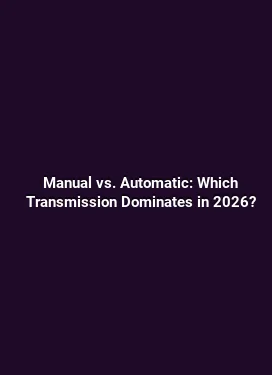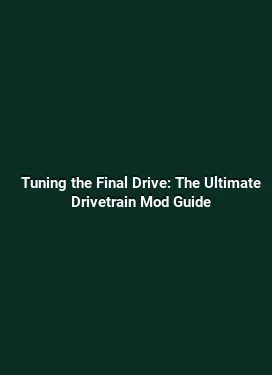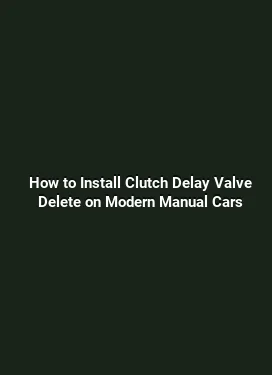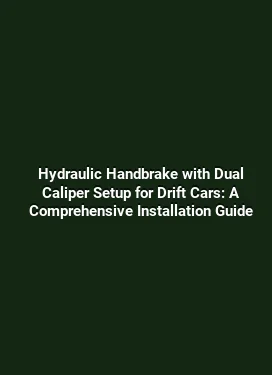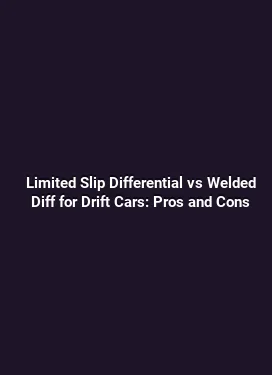Best Shifter Bushings Upgrade for Precise Gear Changes
In the realm of transmission and drivetrain refinement, shifter bushings play a pivotal yet often overlooked role. These tiny components reside in the linkage between the shift lever and the actual shift forks, acting as the critical interface that translates motion into precise gear engagement. Upgrading shifter bushings is a practical strategy to sharpen shift feel, reduce play, and improve repeatability under various driving conditions. This in-depth guide walks through the engineering considerations, material options, installation approaches, and real-world performance outcomes that come with a thoughtful bushing upgrade.
Understanding Shifter Bushings and Why They Matter

Shifter bushings are designed to cushion, align, and constrain the movement of the shift linkage. They absorb vertical and lateral loads that occur during gear changes, helping to maintain consistent throw geometry and reduce micro-movement that can lead to missed shifts. In manual and dual-clutch setups alike, the integrity of the bushing system directly influences the transmission’s response time and the driver’s ability to anticipate and execute precise gear changes.
Over time, standard bushings can wear, crack, or flatten under stress. Heat, vibration, and load cycles from aggressive shifting or spirited driving can degrade performance. When bushings lose rigidity or develop excessive play, the linkage may feel vague, and the shift action can become inconsistent. Upgrading to higher-quality materials or geometry can restore or exceed the original shift fidelity while also reducing unwanted movement that contributes to misalignment or late engagements.
Material Choices: How to Balance Precision, Longevity, and Feel
Material selection is a core determinant of a bushing’s performance envelope. The goal is to minimize deflection while tolerating the thermal and mechanical demands of a daily driver or a dedicated track car. Common materials and their typical trade-offs include:
Polyurethane — A popular choice for performance upgrades due to favorable elasticity and damping characteristics. It offers excellent resistance to wear and a noticeable improvement in stiffness over stock rubber. Polyurethane bushings can provide a more precise feedback through the shifter without becoming overly harsh on prolonged road use.
Delrin (Acetal) — Known for exceptional dimensional stability and low friction, Delrin bearings can maintain tight tolerances under high cycle counts. Delrin bushings tend to deliver a very direct shift feel with minimal compressive travel, which is advantageous for drivers who value immediate engagement and consistent geometry across temperatures.
Bronze or Brass Composites — These metal-based options win on sheer load capacity and longevity in high-stress applications. They resist compression better than polymers, but can transfer more vibration to the shifter. In some builds, bronze bushings are paired with dedicated lubrication to sustain smooth movement over extended track sessions.
UHMW (Ultra-High-Molecular-Weight Polyethylene) — A robust, low-friction polymer that can handle repeated engagement without excessive wear. UHMW bushings often strike a balance between a clean, precise action and comfort on street roads, preserving a natural shift cadence.
Beyond material choice, the geometry and fitment tolerance of a bushing set are equally important. A well-designed bushing not only reduces play but also preserves correct alignment between the shift lever and the transmission’s input shaft. Some upgrades incorporate coatings or surface treatments to further lower friction and extend service intervals.
Geometry and Fitment: Ensuring Optimal Alignment

Upgrade considerations include whether the bushing set provides floating or fixed sleeves, how it accommodates pivot points, and whether the design accommodates angled linkage paths. A geometry that matches the factory kinematics while removing unwanted slop yields a crisper, more repeatable shift. In many cases, manufacturers supply bushings with precisely machined bores and anti-rotation features to keep the linkage oriented under high-G loading.
Upgrading Process: Steps for a Thorough Installation
Given the diversity of drivetrain layouts, the installation process should be approached methodically. Here is a practical workflow that covers common configurations and emphasizes clean execution over a quick swap.
1. Preparation and inspection — Begin by removing the linkage cover or access panel to expose the shifter assembly. Inspect the current bushings for signs of cracking, deformation, or excessive play. Take note of how the linkage moves through its range and identify any聯 binding points or stiff spots that might indicate misalignment or bushing wear elsewhere in the system.
2. Document the linkage geometry — Before removing anything, photograph the current setup from multiple angles. This visual reference helps during reassembly to preserve the original throw length and steering wheel alignment. Mark mounting points if necessary to ensure consistent torqueing and orientation on reassembly.
3. Remove the old bushings — Depending on the design, bushings may be press-fit, snap-in, or threaded into the linkage. Use appropriate tools to avoid damaging the surrounding components. If the bushings are press-fit, a soft-jawed vise and a cutter or punch can help separate the old material without marring adjacent surfaces.
4. Clean and inspect related components — Wipe down all pivot points, clean the bore surfaces, and check for wear on the shift linkage arms themselves. If any part shows elongation or cracking, consider replacing it to prevent premature failure of the new bushings.
5. Install new bushings — Apply a light lubricant if specified by the manufacturer; many modern bushings are self-lubricating or require a specific lubricant type. Align the bushings with their corresponding holes and ensure that the sleeves are seated fully without binding. If the fit is too tight, expand gently with a non-marring tool rather than forcing the part in place.
6. Reassemble and verify — Reassemble the linkage in the reverse order of disassembly. After installation, move the shift lever through its full range of motion to verify smooth travel and correct engagement. Listen for any unusual noise and check for binding at any point in the throw.
7. Test in real-world conditions — Start with gentle driving to confirm the feel in normal operations, then test under moderate loads and spirited driving to confirm that the new bushings are delivering the expected precision without introducing excessive vibration or harshness.
Common Installation Pitfalls
Avoid over-tightening fasteners, which can preload the linkage and create binding. Ensure any coatings or lubricants are compatible with both the bushing material and the mounting surfaces. Finally, do not overlook the possibility of ancillary wear in the shifter linkage joints; sometimes a bushing upgrade should be paired with updated end fittings or pivot bushings to maximize system integrity.
Choosing the Right Bushing for Your Transmission
The selection process should consider the vehicle’s use case, climate, and tolerance for steering or shifting feel. A high-performance road car that sees frequent track days benefits from a stiffer material with low deflection, while a daily driver may benefit from a slightly more compliant option that preserves comfort. The end goal is to strike a balance between decisive, precise engagement and reliable long-term performance.
OEM versus aftermarket options — Original equipment manufacturer bushings are designed to meet broad operating conditions. Aftermarket solutions often target higher rigidity, improved damping, or enhanced longevity. When evaluating options, review the bushing’s temperature range, load rating, and compatibility with other drivetrain components, such as transmission mounts and shift cables.
Compatibility and compatibility testing — Confirm that the chosen bushings fit the specific transmission model, year, and body chassis. Some upgrades are universal, while others are tailored to a given platform. Consulting the manufacturer’s installation guide and customer support can prevent misfits that compromise shifting behavior.
Performance Gains: Real-World Impacts and Driver Perception
Upgrading shifter bushings tends to yield several tangible benefits. A notable improvement is a reduction in perceived play, enabling the driver to engage gears with greater accuracy and confidence. The shift cadence often becomes more linear, with less drift during gear changes, which helps when executing fast, repeated shifts in challenging driving scenarios.
Beyond tactile improvements, upgraded bushings can influence timing consistency. With a stiffer interface, the linkage can transmit the driver’s input more faithfully to the transmission, reducing the chance of partial engagements that might occur with worn or flexible components. This can result in a smoother transition between gears, especially under high-load conditions where precision matters most.
Additionally, the damping behavior of the chosen material affects the amount of vibration transferred to the cockpit. Some drivers prefer a slightly more restrained feel that minimizes transmission noise and resonates with a crisp, deliberate shifting action. Others may opt for a vibration-friendly profile that maintains a livelier connection between the hand and gear lever without compromising accuracy.
Case Studies: What to Expect in Different Setups
In a street-driven sports coupe, upgrading to Delrin or high-quality polyurethane bushings can yield a noticeably tighter feel in the gate without introducing harshness on everyday roads. In a purpose-built track car, bronze or composite materials may offer the durability required to withstand repetitive, high-load pulls while preserving precise throw characteristics. For a daily driver with modest performance goals, UHMW bushings can provide a balanced blend of comfort and improved engagement compared with stock components.
When considering a bushing upgrade as part of a broader drivetrain refresh, it’s common to pair the kit with improved shift linkage alignment, upgraded transmission mounts, or even a revised shift knob geometry. The cumulative effect can be a noticeably more confident driving experience, where each gear change feels intentional and repeatable across a wide range of speeds and conditions.
Maintenance and Longevity: Keeping the Upgraded System Working Optimally
Maintenance practices for upgraded bushings share similarities with those for standard hardware. Regular inspection during service intervals helps detect early wear and potential misalignment before it translates into noticeable drivetrain behavior changes. Periodic cleaning, lubrication where applicable, and confirmation of proper fastener torque are simple steps that preserve performance gains over the long term.
Preventive checks should also include the surrounding linkage and mounting hardware. Loose fasteners, misaligned pivots, or degraded transmission mounts can undermine the gains achieved through a bushing upgrade. Treat the upgrade as part of a system-wide approach to drivetrain stiffness and alignment to maximize the benefits.
Tools and Testing Techniques
Engineers and enthusiasts often rely on simple measurement and feedback tests to quantify improvements. Common techniques include comparing shift feel before and after the upgrade, evaluating engagement consistency across a range of engine speeds, and performing controlled road tests to assess repeatability in downshifts and upshifts. For a more formal assessment, some builders use dial indicators and torque measurement to characterize deflection and load paths through the linkage during operation.
Bottom Line: Making an Informed Upgrade Decision
Shifter bushings are inexpensive relative to many drivetrain components, yet they offer a high-impact upgrade for drivers seeking more precise gear changes and a more engaging driving experience. By selecting a material that matches the vehicle’s use case, ensuring precise geometry and fitment, and following careful installation practices, drivers can unlock meaningful improvements without compromising durability or daily usability.
As with any performance enhancement, it is important to consider the broader context of the transmission’s reliability, race-ready goals, and the driver's preferences. A thoughtful upgrade plan, combined with proper maintenance, can yield lasting improvements in shift quality, confidence, and overall driving satisfaction.

